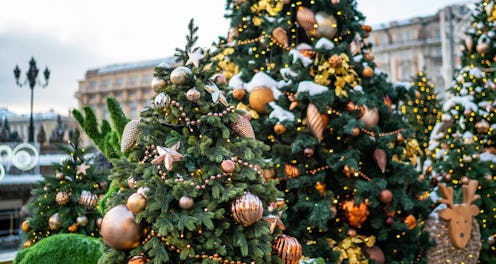Life
The Environmental Pros & Cons Of Real Vs Fake Christmas Trees
Experts weigh in.

For so many people, bringing home a Christmas tree marks the beginning of the festive season. It's quite literally the centrepiece of the holiday. However, with concerns about sustainability growing year on year, a lot of us will be wondering, is a real or fake Christmas tree better for the environment? While Christmas may be the time for mistletoe and mulled wine, it’s also good to think about whether there are any little changes you can make to ensure you’re being as eco-conscious as possible at this time of year.
Speaking to the BBC in December 2016, Dr John Kazer from the Carbon Trust revealed that a two-metre artificial Christmas tree has a carbon footprint equivalent to 40kg of greenhouse gas emissions due to the way in which it is manufactured (fake trees are most often made from plastic). That is more than twice that of a real tree that ends its life in landfill, Kazer says, and more than ten times that of a real tree that is burnt.
"So if you have an artificial tree at home you would need to reuse it for at least 10 Christmases to keep its environmental impact lower than that of a real tree," Kazer told the BBC.
Research conducted in 2017 found that six million Christmas trees are discarded every year and 14% of people who opted for an artificial tree said they would be binning it after one use. Similarly, the Waste and Resources Action Program estimated that 160,000 tonnes of real trees are thrown away after Dec. 25.
Friends of the Earth Campaigner Emi Murphy tells me, "If you've got a fake tree already, keep using it — make it last as long as possible. But look into a more environmentally-sound option when it eventually comes to replacing it."
Murphy continues: "Real trees may seem an obvious solution, but if you’re only using it for one Christmas, it can have a big impact when you think about the land use to grow it and the emissions from transport." You can check to see if your tree is FSC-certified which ensures that it was grown in an environmentally responsible way.
Speaking about real trees, Kazer pointed out to the BBC that the way in which they are disposed of is "much more significant than where it comes from." He continued: "If you burn your Christmas tree on the bonfire, plant it or have it chipped to spread on the garden, that significantly reduces the carbon footprint by up to 80% or around 3.5kg CO2e (greenhouse gas emissions)."
On the whole you don’t need to worry too much about deforestation when you’re picking out a Christmas tree as certification officer at Soil Association Forestry, Anne Mari Cobb told the Independent the majority, “are grown as a horticultural crop and aren’t felled from pre-existing forests.” So as long as you responsibly recycle or dispose of your Christmas tree, you’ll be helping to reduce its impact on the environment.
If you want to be as environmentally conscious as possible with your tree, Murphy from Friends of the Earth says, you could consider growing your own. "Buying a potted tree with roots lets you grow it outside and use it again year after year, reducing its environmental impact and costing you less," she says. "A living tree will carry on absorbing carbon from the atmosphere for years to come." Nurturing a tree year after year is also a pretty cute family Christmas tradition.
According to The Woodland Trust it takes about eight to ten years to grow a Christmas tree to optimum height, so it’s ideal if you’re a keen gardener or are someone who’d be happier with a more petite tree. You don’t need a massive garden to grow your own tree, either. Murphy suggests: “Potted trees like holly are good options and can be placed on a small balcony or outdoor space.”
And if you want to go the extra mile you can use a Christmas tree rental service, such as the London Christmas Tree Rental. All you have to do is go and pick up a real tree, keep it in good condition and water it, and then return it after the festive season.
You can still enjoy this time of year while also being eco-conscious, Murphy says. "Just making slightly different choices around decorations, food, gifts and travel can really cut down on the impact your festivities have," she explains. It’s not about completely changing your Christmas Day traditions but making slight adaptations to be more sustainable. As well as getting a real tree Friends of the Earth suggest you consider buying local and organic food to go on your festive tables, resist buying cheap, flimsy plastic baubles and tinsel, and think about what experiences your family might enjoy receiving as a gifts instead of a physical item.
This article was originally published on